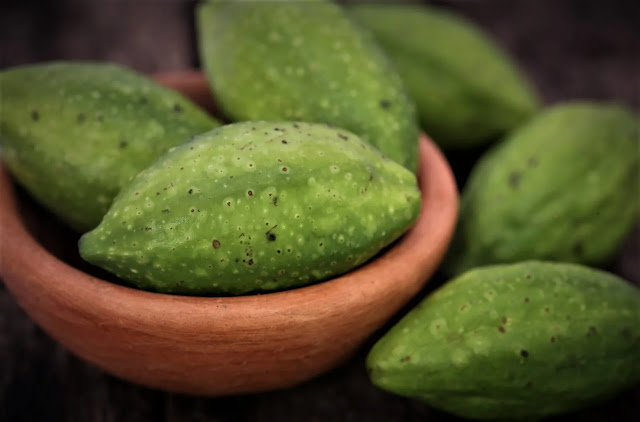Harītakī is the sanskrit name of Terminalia chebula Retz. English name of this herb is ink nut. It is one among the triphala. Along with āmalakī and vibhitakī, harītakī is commonly used in ayurveda formulation. Here are the details about harītakī, presented in table form.
|
Sanskrit name |
Harītakī |
|
Synonyms of
sanskrit name |
Abhayā Pathyā Jīvanīyā Kalih Kāyasthā Pūtanā Rohiṇī śivā Śreyasī Sudhā Vayasthā |
|
Botanical name |
Terminalia
chebula Retz. |
|
Synonym of
botanical name |
Buceras
chebula Lyons Myrobalanus
chebula Gaertn. Myrobalanus
gangetica Kostel Terminalia
acute Walp. Terminalia
chebula var. Chebula Terminalia
gangetica Roxb. Terminalia
parviflora Thwaites Terminalia
reticulata Roth. Terminalia
zeylanica Van Heurck |
|
Family |
Combretaceae |
|
Vernacular
name |
|
|
English |
Ink
nut |
|
Hindi |
Harre,
harda |
|
Malayalam |
Kaṭukkā |
|
Kannada |
Alalekai |
|
Part
used |
Fruit |
|
Guṇa (properties) |
Laghu (light) Rukṣa (dry) |
|
Vīrya (potency) |
Uṣṇa (hot) |
|
Vipāka (metabolic
effect) |
Madhura (sweet) |
|
Karma (action) |
Rasāyana (Rejuvenating) Medhya (Improve
intelligence) Hṛdya (Cardiac tonic) Dīpana (Appetizing) Cakṣuṣya (Eye tonic) Vātānulamana (Vāta
channelizing) |
|
Prabhāva
(special
action) |
Mitigates tridoṣa
(humors) |
|
Taste
(rasa) |
Kaṣāya (Astringent) Madhura (Sweet) Amla (Sour) Kaṭu (Pungent) Tikta (Bitter) |
|
Indication |
Aruci (anorexia) Arśas (Hemorrhoids) Aśmari (calculi) Chardi (Vomiting) Gulma (phantom tumor) Hṛdroga (heart
diseases) Jīrṇa jvara (chronic fever) Kāsa (cough) Klaibya (impotency) Krimi (worms) Kuṣṭha (skin diseases) Mutra Kṛcchra (dysuria) Netra roga (eye diseases) Pāṇḍu (anemia) Prameha (diabetes) Śiro roga (head diseases) Sopha (oedema) Śvāsa (asthma) Udāvarta (retrograde
intestinal movement) Udara roga (stomach
disorders) Vātaśoṇita (inflammatory
arthritis) Vibandha (constipation) Viṣama jvara (remitten
fever) Vraṇa (wound) |
|
Agryauṣadha
(prime remedy) |
Patya
(wholesome) Kṣatakṣaya
(Debilitation
because of trauma) Anila
kaphahara (decrease
vāta and kapha) |
|
Formulation |
Amṛtādya
ghṛta Brahmī
ghṛta Caitasa
ghṛta Ciribilvādi
ghṛta Dārvī
balādi ghṛta Daśasvarasa
ghṛta Guḍūcyādi
ghṛta Haridrādi
ghṛta Jīvantyādi
ghṛta Kalyāṇa
ghṛta Kalyāṇaka
ghṛta Rohiṇyādi
ghṛta Sārasvata
ghṛta Simhyamṛta
ghṛta Śūlārikam
ghṛta Trayūṣaṇādi
ghṛta Triphalādi
ghṛta Vāśādi
ghṛta Saindhavādi
varti Agastya
rasāyana Agastya
harītakī Gandhaka
rasāyana Guḍabhallātaka Bāhuśāla
guḍa Kalyāṇa
guḍa Kauṭacādi
guḍa Kalyāṇa
kṣāra |
|
Morphology |
|
|
Types |
Tree-
50 to 80 feet height. |
|
Leaves |
Ovate,
3-8 inches long, 2-4 inches wide, 5-8 veins. |
|
Fruits |
Oval,
1-2 inches long, hard with prominent line, green when unripe, yellow-brown on
ripening, have 1 seed. |
|
Flowers |
Small.
Yellowish-white, grows in a cluster. |
|
Bark |
Dark
brown and have cuts. |
|
Root |
|
|
Habitat |
India,
in lower Himalaya |
|
Chemical
content |
Anthraquinone
glycoside Vitamin
C Terchebin Tannic
acid Chebulinic
acid Oleic
acid Palmitic
acid Stearic
acid (in fruit kernels) Linoleic
acid Behenic
acid Arachidic
acid Chebulin
(in flowers) |

No comments:
Post a Comment